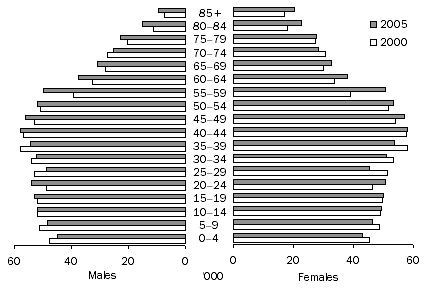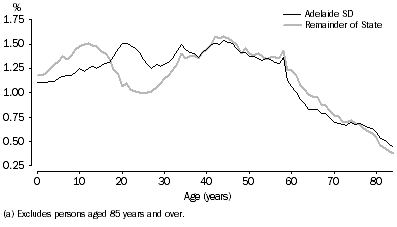|
SUMMARY
The estimated resident population of South Australia at 30 June 2005 was 1,542,000, an increase of 9,300 (0.6%) since 2004. In 2005 South Australia's population was 7.6% of the Australian total.
In 2005, almost three quarters (73.2%) of the state's population resided in the Adelaide Statistical Division (SD), a proportion virtually unchanged since 2004. Outer Adelaide was the fastest growing SD in the state with an increase of 2.1% (2,600 people) from 2004 to 2005. Northern was the only SD to experience a decline in population (0.7%) over the same period.
In the 12 months to June 2005, the fastest growing Local Government Area (LGA) in South Australia was Alexandrina (DC), which increased by 2.9%, followed by Light (RegC) (2.7%) and Adelaide (C) (2.6%). The fastest declines were recorded in Coober Pedy (DC) (5.6%), Ceduna (DC) (1.5%) and Roxby Downs (M) (1.3%).
AGE DISTRIBUTION
South Australia has continued to age with people aged 65 years or more contributing 15.2% of South Australia's population in 2005, compared with 14.5% in 2000. While the proportion of older residents in South Australia continues to increase, the proportion of younger people continues to decline. At 30 June 2005, the proportion of the state's population who were children aged under 15 years was 18.4%, compared with 19.5% in 2000.
POPULATION, SOUTH AUSTRALIA, 2000 and 2005

|
Median age
South Australia's median age continues to be the highest of all states and territories in Australia, with the median age (the age at which half the population is older and half is younger) increasing from 37.2 years in 2000 to 38.8 years in 2005. This is consistent with the national trend, with Australia's median age increasing from 35.4 years in 2000 to 36.6 years in 2005.
Among the SDs in South Australia, the highest median age was recorded by Yorke and Lower North (45.1 years). The SDs with the lowest median age were Eyre, South East and Northern (all with a median age of 37.6 years).
The LGA with the highest median age was Victor Harbor (C) at 53.3 years. Other LGAs with relatively high median ages were Yorke Peninsula (DC) (48.3 years), Barunga West (DC) (47.9 years) and Orroroo/Carrieton (DC) (47.5 years). The LGAs with the lowest median ages were Anangu Pitjantjatjara (AC) (27.3 years), Roxby Downs (M) (29.2 years) and Playford (C) (33.8 years).
Children (under 15 years)
In 2005, South Australia had the lowest proportion of its population aged 0 to 14 years (18.4%) of all states and territories. Nationally 19.6% of the population was in this age group. In South Australia the total number of children declined from 285,800 in 2004 to 283,600 in 2005, a decrease of 0.7%.
The South Australian SD with the highest proportion of its population aged under 15 in 2005 was Eyre (21.6%). Adelaide had the smallest proportion of its population aged under 15 (17.6%), which was also the smallest proportion for all SDs in Australia. All South Australian SDs apart from Outer Adelaide experienced a decline in the number of children from 2004 to 2005. The Northern SD had the largest percentage fall, 2.2% (370 children), while the largest numeric decrease was in Adelaide SD with a decline of 1,400 children or 0.7%.
The largest proportions of children were recorded in the LGAs of Roxby Downs (M) (30.6%), Anangu Pitjantjatjara (AC) (26.1%), Ceduna (DC) (24.9%) and Playford (C) (23.8%). With 6.1% of its population aged under 15 years, the LGA of Adelaide (C) had the smallest percentage of children of all South Australian LGAs, followed by Holdfast Bay (C) (12.0%), Victor Harbor (C) (13.1%) and Norwood Payneham St Peters (C) (13.4%).
Persons aged 15 to 44 years
In 2005, the proportion of South Australia's population who were aged 15 to 44 years was 40.8%, a figure lower than that for Australia (42.8%). In South Australia the total number of people in this age group (629,100) declined marginally in the 12 months to June 2005, by 0.1%. Nationally there was an increase of 0.6% over this period.
The SD with the highest proportion of people aged 15 to 44 was Adelaide (41.9%) while the lowest was Yorke and Lower North (31.8%). Between 2004 and 2005, Outer Adelaide recorded the largest increase in this age group (580 people or 1.3%), while the largest decreases were in Northern (2.0%) and Adelaide (0.1%), both SDs declining by 620 people.
The LGAs with the highest proportion of their population aged 15 to 44 were Adelaide (C) (58.0%), Anangu Pitjantjatjara (AC) (53.0%) and Roxby Downs (M) (52.5%). LGAs with the lowest proportion were Victor Harbor (C) (26.4%), Yorke Peninsula (DC) (28.6%), Peterborough (DC) (28.6%) and Barunga West (DC) (29.0%).
Persons aged 45 to 64 years
The proportion of South Australia's population aged 45 to 64 years in 2005 was 25.6%, which was higher than the national figure of 24.5%. In South Australia the total number of people in this age group rose from 386,300 people in 2004 to 394,600 in 2005, an increase of 2.1%. Nationally there was an increase of 2.5%.
The SD with the highest proportion in this age group was Yorke and Lower North (29.6%), and the lowest proportion was in Northern (25.1%). All SDs in South Australia experienced an increase in this age group, with Outer Adelaide having the greatest percentage increase of 4.0% (1,320 people) from 2004 to 2005. All other SDs showed an increase ranging from 0.9% in Northern to 3.0% in Yorke and Lower North.
LGAs with the highest proportion of population in this age group were Coober Pedy (DC) (33.0%), Karoonda East Murray (DC) (31.5%), Clare and Gilbert Valley (DC) (31.5%) and Orroroo/Carrieton (DC) (31.4%). The LGAs with the lowest proportion were Roxby Downs (M) (15.6%), Anangu Pitjantjatjara (AC) (15.9%), Playford (C) (20.8%) and West Torrens (C) (22.2%).
Persons aged 65 years and over
In 2005, the proportion of the South Australian population aged 65 years and over was the highest among all states and territories at 15.2% (234,800 people). The national proportion was 13.1%. In South Australia the total number of people in this age group increased by 4,100 from 2004 to 2005, an increase of 1.8%.
The SD with the highest proportion of its population aged 65 years and over was Yorke and Lower North (20.6%), followed by Murray Lands (15.8%). The lowest proportion was in South East (13.6%). From 2004 to 2005 the SD with the fastest increase in population aged 65 years and over was Outer Adelaide with a 3.3% increase.
South Australian LGAs with the highest proportion of population aged 65 and over were Victor Harbor (C) (31.8%), Barunga West (DC) (23.7%), Holdfast Bay (C) (23.6%) and Yorke Peninsula (DC) (23.5%). The LGAs with the smallest proportion were Roxby Downs (M) (1.3%), Anangu Pitjantjatjara (AC) (4.9%), Mallala (DC) (9.0%) and Mount Barker (DC) (10.1%).
Persons aged 85 years and over
In 2005, South Australia had the highest proportion of people aged 85 years and over for any state or territory, at 1.9% of the total state population. Nationally this proportion was 1.5%. In South Australia the number of people in this age group rose from 28,000 people in 2004 to 29,900 in 2005, an increase of 6.8%. The growth in this age group is in part due to declining mortality rates.
The SD with the largest proportion of its population aged 85 years and over was Yorke and Lower North (2.3%) while the lowest was Northern (1.6%). From 2004 to 2005 the SDs with the fastest increase in population aged 85 years and over were Northern (8.9%), Eyre (8.0%) and Adelaide (6.9%).
The LGAs of Holdfast Bay (C) (4.6%), Orroroo/Carrieton (DC) (4.3%), Victor Harbor (C) and Franklin Harbour (DC) (both 3.7%) had the highest proportion of their population aged 85 years and over in 2005. The LGAs with the lowest proportion were Roxby Downs (M) (0.2%), Anangu Pitjantjatjara (AC) (0.4%), Elliston (DC) (0.5%) and Coober Pedy (DC) (0.7%).
Age distributions of Adelaide and the remainder of South Australia
The varied age distribution throughout South Australia is particularly noticeable when comparing Adelaide SD with the remainder of the state. As shown by the graph below, Adelaide SD has a lower proportion of people aged under 18, a higher proportion of people aged 18 to 38 years and a lower proportion of people aged 55 to 75 years, compared with the remainder of the state.
AGE DISTRIBUTION (a) - 30 June 2005

SEX RATIO
In June 2005, females outnumbered males in South Australia by 13,600. With 764,200 males and 777,800 females at June 2005, the state's sex ratio (number of males per 100 females) was 98.3. The sex ratio for South Australia was below that of Australia (99.0).
Despite females outnumbering males in South Australia, males outnumbered females in all SDs except Adelaide and Outer Adelaide. Sex ratios across SDs ranged from a low of 96.6 in Adelaide to 105.2 in Eyre.
For young adults aged 20 to 29 years old, the SD with the highest sex ratio was Yorke and Lower North (121.1), followed by Murray Lands (118.4). In contrast, the SDs with the lowest sex ratios in this age group were Adelaide (105.5) and Outer Adelaide (108.5).
The LGAs with the highest ratio of males to females in the 15 to 64 year age range (the working age population) were Roxby Downs (M) (138.9), Karoonda East Murray (DC) (125.7), Streaky Bay (DC) (125.2) and Adelaide (C) (123.8). The lowest ratios occurred in Victor Harbor (C) (94.2), Unley (C) (94.7), Burnside (C) (94.8) and Campbelltown (C) (96.4).
In South Australia, the number of females aged 65 years and over (131,600) was almost 30% higher than the number of males in this age group (103,200) in 2005, and there were more than twice as many females (20,400) as males (9,500) aged 85 years and over. The lower sex ratios for the more elderly age groups illustrates the greater life expectancy of women. |
 Print Page
Print Page
 Print All
Print All